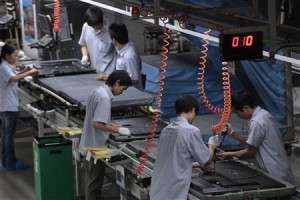 Two new Chinese LCD screens in Beijing’s imposing Great Hall of the People will replace screens made by a Japanese competitor, in a sign of resolve to supply the world with Chinese brands and not just Made in China products.
Two new Chinese LCD screens in Beijing’s imposing Great Hall of the People will replace screens made by a Japanese competitor, in a sign of resolve to supply the world with Chinese brands and not just Made in China products.
The screens are made by Chinese electronics giant TCL. At 110 inches, they are the world’s largest high-definition 3-D LCD screens, just a touch wider than the 108-inch Panasonic models they will replace.
“We have broken through the Japanese and South Korean monopoly of big flat-screen TVs!” TCL chairman Li Dongsheng boasted at a launch ceremony on Friday. Officials from the Ministry of Commerce, Ministry of Science and Technology, Ministry of Industry and Information Technology (MIIT), and the government of Shenzhen, TCL’s hometown, clapped and nodded.
The government is encouraging its companies to move up the value chain and develop margin-producing brands, partly as a matter of national pride but also to shift the world’s second-biggest economy away from gritty, low-profit manufacturing.
But creating recognizable brands has not been easy.
With the possible exception of computer-maker Lenovo and appliance maker Haier, China has few brands that foreign shoppers would recognize. Even at home, producers often find themselves supplanted by high-end foreign brands.
“That is a big hurdle, especially in autos. (The domestic brands) are almost non-existent in large cities like Shanghai or Beijing because no one wants to be seen going lower than a Japanese or a Korean brand,” said James Roy, a senior analyst with China Market Research Group, a Shanghai-based consultancy.
Beijing has been ready to lend a hand.
This month, MIIT posted new rules requiring officials, who overwhelmingly prefer German luxury brands like Audi, to buy only local cars.
Other efforts, including government support for domestic companies engaged in “indigenous innovation”, have led to allegations that China is unfairly trying to tilt the playing field towards its own industry by guaranteeing government purchases and by setting standards that favor Chinese companies over established industry leaders.
“If Chinese companies want to go global, they can’t just compete in a protected domestic market,” said Zhao Yuhai, high- and new-technology development and commercialization director general at the Ministry of Science and Technology.
“That way you will never win the global market. So this concern is unnecessary,”
CAR-VING OUT A MARKET
For policymakers, overseas presence is a sign that a brand has succeeded.
Companies aspiring for international brands should aim to earn one-fifth their revenues and one-third of their profits from sales abroad, Yang Mianmian, the president of the world’s largest appliance maker Haier, told the National People’s Congress, or parliament, a few years ago.
Haier sells compact appliances like washing machines and mini-fridges under its own name in the United States, but still sells in Europe under European brand names. Few other companies have reached even that level.
“Some brands have started (to get international recognition), but most need more work,” Zhou said.
“Of course, there are different kinds of markets, high-end and low-end, and I think brands like TCL are still at the mid-to-low-end stage. But they’ll move up.”
TCL sells under its own name in developing markets, but markets under the Alcatel, Thomson and RCA brands in the West.
“To fully sell under our own name isn’t a question of technology but of marketing. Because if we promote a new brand, our own brand, it would take time,” TCL’s Li told Reuters.
“If there is already a local established partner, using their brand is quicker. For our company, the most important is bigger sales turning into greater revenue.”
For many companies those big sales come at home. Unlike South Korea or Taiwan, China’s domestic market is big enough that many producers do not yet need to focus on developing international brands, said Roy of China Market Research Group.
“That there aren’t many Chinese brands that are globally known shouldn’t necessarily suggest that Chinese companies don’t know how to brand,” he said. “The main opportunity for brands has been the domestic market.”
The auto industry is still a major front in the brand wars. The government hinted to foreign automakers last year that applications to expand joint venture production were unlikely to be approved unless they worked with their Chinese partners to develop Chinese-branded cars.
General Motors has since launched the “Baojun” (Treasure Steed), although it denies that it was in response to Chinese government pressure.
The policy helps correct what planners now see as a mistake — although China is the world’s largest vehicle market, it lacks the defining national auto brand enjoyed by such smaller markets as Korea, Malaysia, the Czech Republic, even Poland.
When China married foreign automakers to its largest state-owned firms, the unexpected consequence was that the joint ventures saw rocketing output, but left the state-owned firms with zero incentive to develop by themselves.
Source : Reuters




































